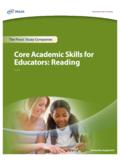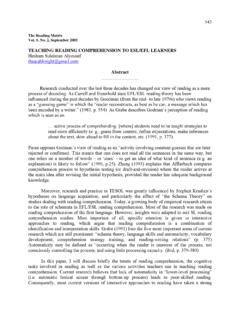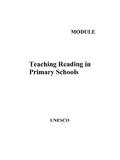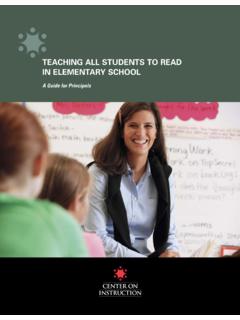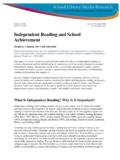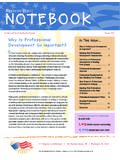Transcription of 102 PART II Instruction and Assessment 6 Teaching …
1 102 PART II Instruction and AssessmentRemember the first time you saw a video of a dung beetle in action? Or a photograph showing the microscopic mites that thrive in our pillows and mattresses by the tens of millions? As your teacher intended, those images definitely got your attention and drew you into the subject at hand. That engagement also supported your learning of the appropriate vocabulary . What your teacher may not have shared with you, how-ever, are the meanings and connotations couched within the structures of the words (see Figure ).
2 For example, the Latin term for one family of dung beetle is trox horridus, a name that immediately signifies something horrid. The literal meaning is even creepier; trox means to gnaw, so this type of beetle is literally a horrid gnawer. Another Latin term, dermatophagoides, for a family of mites, literally means skin eating. Both of these terms include word parts that most students may recognize in other more familiar words such as horrid and dermatologist. And this is where much of the value lies in sharing and examining the structures or spellings of the words themselves that represent concepts large and small.
3 Connections are made within content area concepts such as dung beetles, mites, and their functions and concepts and general experience. A specific dung beetle (horridus, scary ) leads to associations with horrid and horrible. The concept that the word represents and the spelling of the word itself work together to deepen students observed that the mastery of academic subjects is the mastery of their spe-cialized patterns of language use (1988, p. 81). As you help students construct knowl-edge of your discipline, you re also helping them learn the language of your discipline: the words that historians, mathematicians, or scientists use to talk about their worlds.
4 Toward this end, this chapter uses the following organizational framework:An overall instructional emphasis on generative and word- specific strategies and activities for each content area. Examples are grouped together to encourage thinking across the sub-ject matter areas and to underscore the similarities among ways of approaching different Teaching content - specific academic Vocabulary10266 CHAPTERCHAPTERFIGURE Trox Horridus and DermatophagoidesCHAPTER 6 Teaching content - specific academic vocabulary 103strategies and activities across all disciplines.
5 As you read and think about each of the content areas, please keep in mind how activities may also be used, with different content , at any level of Instruction for that subject. In addition, it is important to keep in mind that most activities work before, during, and after reading or exploring a unit. The examples provided in this chapter should help to illustrate this. Because prior misconceptions held by students are often difficult to break even in the face of new facts (cited in Pearson, Hie-bert, & Kamil, 2007), by returning to earlier activities in a unit such as concept sorts and graphic organizers, students are much better able to determine what has been learned and is now understood that might have been unknown or confused of generative Greek and Latin roots and affixes for each content area.
6 These tables include only those roots and affixes that occur most often in a particular discipline. Becoming familiar with these generative elements, therefore, should provide students with a leg up on learning much of the vocabulary in that content area. As an additional generative element, many of these roots and affixes occur in other to become comfortable talking about how roots and affixes combine to create meaning. Examples are provided throughout the chapter for each content area, illustrat-ing the ways that teachers can discuss the meanings that result from combining gen-erative elements.
7 Some of these word narratives are straightforward and literal an equilateral triangle has three (tri, three ) sides that are equal (equ, equal + later, side ). Some are more general endogenous is the quality of being produced from within (gen, produce + endo, within ). Students will still need to learn many specific examples of this process. An understanding of the general meanings produced by combining the word parts, however, will be a strong memory hook on which students can hang the the vast majority of words and their parts, however, we leave the narratives to you.
8 You understand the nuances of the language of your content area. What we hope to do is help you realize the potential for these narratives to enhance content area study. The more you think about specific words and the generative elements of the words in your discipline, the more confident and comfortable you become talking about the words and language of your AND THE content AREA TEXTBOOKThe core resource for most content area teachers is the textbook. Together with continu-ally evolving Web support, textbooks reflect the content standards for the subject and grade level.
9 These standards are established by each state, usually with close attention to the standards developed by the professional organization of each discipline, such as the National Council for the Social Studies ( ), the National Council for Teachers of Mathematics ( ), and the National Science Teachers Associ-ation ( ). Though textbooks may be the core resource, however, they should not be the sole resource. content teachers supplement, elaborate, and extend instruc-tion in many ways, and these should include the approach to and types of vocabulary Instruction presented in this chapter.
10 The concepts and vocabulary that are presented in your district s adopted curriculum, represented by the core textbook, should be a very good guide to your vocabulary selection and the structure of the textbook is an important part of developing the necessary background for a content area, scaffolding knowledge for exploring the disci-pline and its language and vocabulary . The organization of the textbook usually reflects the structure of the discipline. In algebra, for example, simple operations and equations precede and are necessary for understanding polynomials and factoring.










